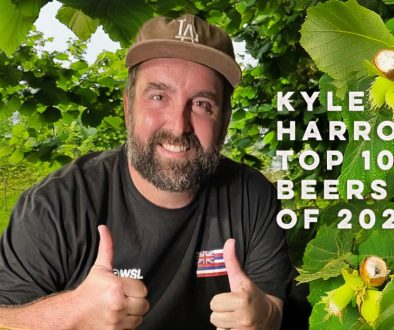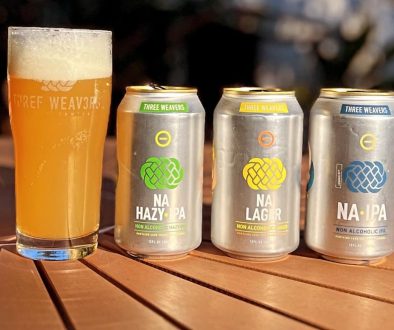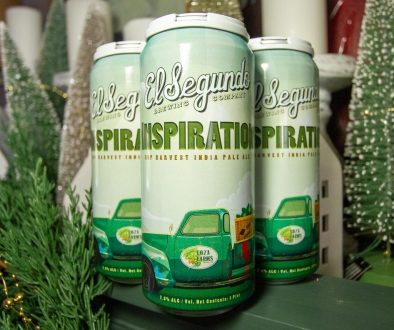Brewers Comment on Shocking GABF Juicy / Hazy Category Adoption

This past week, the Brewers Association announced that they received an overwhelming response to introducing the new hazy/juicy Pale Ale / IPA / Double IPA, overtaking the ultra-popular American IPA category. Here’s the memo they sent out with some pretty impressive adoption statistics.
Earlier this year, a trio of juicy or hazy styles were formally incorporated into the Brewers Association Beer Style Guidelines. The 2018 Great American Beer Festival® (GABF) marks the first time “Juicy or Hazy Pale Ale,” “Juicy or Hazy India Pale Ale,” and “Juicy or Hazy Imperial or Double India Pale Ale” will be judged and awarded medals.
However, what you might not know yet is that the number of entries for juicy or hazy styles in their first year indicates that the haze craze has more than arrived. Just take a gander on the following stat for GABF 2018…
The total number of entries for all three of the juicy or hazy styles is 706
That statistically staggering sum is divided as follows:
- Juicy or Hazy Pale Ale: 131
- Juicy or Hazy IPA: 414
- Juicy or Hazy Double IPA: 161
With 331 entries, this marks the first time in over a decade and a half that American-Style IPA is no longer the top entered beer style
This marks the first time in over a decade and a half that American-Style India Pale Ale—which received 331 entries—is no longer the top entered beer style in the U.S. commercial beer competition.
Since this style of beer has become popular over the last few years, there has been much debate over the quality and validity of these types of beers. With the inclusion into the GABF competition and the overwhelming success, it has left less room for questions and concerns such as “is this just a fad?” or “this isn’t a real style, it’s a shortcut.”
Even with the alarming adoption rate and market acceptance, there are still classically trained brewers out there who are having a hard time adapting to the hazy changes in the market. There are still some valid concerns from a technical standpoint, mainly shelf stability and subsequent beer appearance, and many of these will be addressed with this very competition. It’s believed that the hazy/juicy IPA is a beer not built to last longer than four weeks. The problem is, the GABF competition requires submissions to be sent in one month in advance.
READ: 10 REASONS WHY BREWERS AND DRINKERS HATE ON HAZY IPA
We reached out to a handful of well-respected brewers of both American IPAs and juicy/hazy IPAs, many of which have years of experience competing and judging in the competition, to see what they think of the overwhelming response to the new category as well as any other thoughts or concerns.
Daniel Carey, Master Brewer of New Glarus Brewing
“Anything that brings excitement to the craft brewing industry is good. I’ve spent many years trying to explain to some customers why our Hefeweiss beers are hazy so have a sense of relief that ‘haze is now cool’!”
Mitch Steele, Brewmaster at New Realm Brewing, Author of IPA: Brewing Techniques, Recipes and the Evolution of India Pale Ale
“I think this is a very important development. First time in 17 years standard American IPA is not the most entered category. That’s significant, and very telling about where the industry is going. This isn’t a fad. I enjoy the style a lot when it’s done well, but I still like my bitter clear IPAs too! I hope there’s room for both!”
Julian Shrago, Owner and Brewmaster of Beachwood Brewing
“Best of of luck to all the breweries who entered this category! Can’t wait to see who medals and how the category was judged overall. I think brewers are eager to see how this category takes form in years to come.”
Andy Miller, Brewer at Great Notion Brewing
“I think it’s great that it’s the most popular category. We believe that the style is hugely popular because it continues to cater to hop heads, while also catering to people that would not have enjoyed an IPA during the IBU wars.
Unfortunately, we have to ship our competition beers before our kegs we are serving at the festival. I really hope the BA can move the deadline for the IPA categories closer to the competition. Why not have them due when fresh hop beers are due? I’m sure there’s a logistical reason for this, but I would think it would be in a competition’s best interest to judge the style at its peak.”
Matt Brynildson, Brewmaster at Firestone Walker Brewing
“I’m a brewer who went to the Siebel Institute of Brewing Technology back in the 1990’s, which means I learned text book brewing from industry leaders of that time. That course work taught us classical brewing techniques with a focus on brilliant American light lager and equally bright English ales. We learned the 101s of better beer production through the prism of the international light lager movement. There was very little focus at that time on even the very basics of dry hopping or many of the unique techniques used by modern craft brewers today. We were taught that well-made beer was bright, balanced, highly drinkable and had an expected shelf life. That said, we also learned about and brewed Bavarian Hefeweizen, Belgian Wit beer and other haze appropriate styles. There are beers in the world that are hazy. Our brewing industry has shifted and morphed in so many ways since the 1990’s. Hops and hoppy beer has been at the center of so much of this evolution. I’ve had the great fortune to live and brew though what I see as the three main progressions or generations of Craft IPA brewing. We went from hop forward, amber colored, dry hopped pale ales to extremely bitter, pale, strong and highly dry hopped West Coast style beers and now we have moved into a phase of lowered bitterness, fruit forward late hop and yeast expressive IPAs that present themselves hazy like Hefeweizen. I love it all and I feel it all has a place in the well-rounded brewer’s tool box. It was hard, at first, for an old timer like me to adjust to physically unstable, visually turbid “IPA” beers being held up as the best in class when I was taught that physical stability and visual clarity were paramount in better IPA production. That said, I see this new style closer akin to Bavaria Hefeweizen then classical IPA and in some ways wish we would have been forward thinking enough to not call it IPA… but I digress. At the end of the day, the excitement amongst brewers and more importantly, the enthusiasm demonstrated by the craft beer consumer over hazy IPA style beers, is something a brewer must acknowledge at some level. I’m a curious guy at heart and I love a beer challenge. For me, hazy IPA is an amazingly interesting American craft brewer invention and is yet another style of beer to study. I hope that when my brew team engages in making these beers, we will execute at the highest level possible and bring a professional, stable, repeatable product to market. Traveling the country and seeing these beers in every craft pub and brewery, it is no surprise that this new style has taken the GABF competition by storm and my guess is that this style will be around just as long as West Coast IPA or maybe even longer.”
Chuck Silva, Co-Owner and Brewmaster at Silva Brewing
“Holy crap! Did I hear correctly, over 700 entries for the hazy categories?, when my wife MJ read me the news. It’s a mad dash to win the first medals for a hazy IPA for sure! I hear some brewers say “I’m so over it!”, and I wonder if this will be a short lived trend in brewing, but looking at the numbers is sure compelling.”
Alex Tweet, Co-Owner and Head Brewer of Fieldwork Brewing
“I think it’s safe to say that the proverbial can of worms that is “Hazy IPA” has been opened, poured out onto the ground, stomped on, pissed on, and burnt with a magnifying glass. In all seriousness though, it says a lot about how fast trends move in beer in the age of Instagram and Untappd. Just two years ago the soundboard of the industry was overwhelmed with vitriol regarding non-clear IPA; and whether it be from acceptance of brewing merit or by customer demand it’s caught on enough to steamroll classic IPA at GABF. Everyone can say what they want, and I am sure they will, but I think we can all agree that the positive takes from this is that the Brewers Association is showing intelligent adaptivity and that fruit IPA is dead.”
Kris Ketcham, Brewer at Stone Brewing
“This is proof that consumers are changing the landscape of beers and brewers are taking notice. Let’s see how it plays out and who will shock them all. There will probably be a Brut IPA category someday.”
Kelsey McNair, Owner and Head Brewer at North Park Beer Co.
“This came as no surprise to me and I am pleased to see the Brewers Association add these styles to their recognized categories. In my opinion, this style of brewing was completely validated by the fact that there are several breweries in the country who brew virtually nothing other than these beer styles, and those breweries have quickly become some of the highest regarded and highest rated on popular beer consumer rating forums. In our taproom, we see these beers appealing to the entire spectrum of beer drinkers ranging from the most seasoned beer nerds to the uninitiated. To deny the popularity would be ignoring an emerging segment of beer drinking public’s interest and ignoring key sales trends for the independent brewing industry. I do not see this as a style such as Black IPA which quickly peaked in interest and then rapidly diminished. Brewers did not create lines of ravenous beer geeks that wrapped around the block of their brewery eagerly awaiting a Black IPA release. That said, I do suspect that the hype for Hazy IPA will at some point drop if more and more brewers fully embrace brewing these styles with the highest level of quality. This is not a lazy style as many brewers will suggest. It is a style that requires a lot of attention to detail, atypical hopping methods, and quite frankly, an absurd amount of hops used in all the right ways in order to hit every note. Just as with any other beer style, those who seek critical feedback and the potential to earn awards for their efforts will have the opportunity to do so this year at GABF, which I think is a very good thing.”
Jeff Erway, Owner and Head Brewer at La Cumbre Brewing
“It’s no secret that this category of beers has created more excitement than any in the history of craft beer. Whether we as brewers like them or not, the consumers have spoken with their wallets and they want these styles and they are willing to pay a premium for them. The entries in this category at GABF are only a symptom of the market and the market is speaking loud and clear.”



